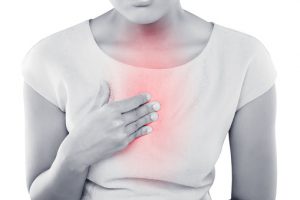 Suffering from substernal chest pain can be quite painful. It is a type of pain felt behind the sternum bone; a flat bone located in the middle of the chest. This bone may also be referred to as the breastbone. Due to the relative location of substernal pain, it is often confused with a variety of different medical conditions, which can induce unnecessary anxiety in sufferers.
Suffering from substernal chest pain can be quite painful. It is a type of pain felt behind the sternum bone; a flat bone located in the middle of the chest. This bone may also be referred to as the breastbone. Due to the relative location of substernal pain, it is often confused with a variety of different medical conditions, which can induce unnecessary anxiety in sufferers.
Chest pain of any nature prompts medical professionals to think of cardiogenic issues first. They want to rule out the most pressing issues first, like those involving vital organs.
Advertisement
Potential substernal chest pain causes include myocardial infarction (heart attack), pulmonary embolism, aortic stenosis, stable angina pectoris, acute coronary syndrome, atrial fibrillation, pneumonia, and severe anxiety and panic attacks, just to name a few.
Symptoms of substernal chest pain
Depending on the specific cause of the substernal chest pain, symptoms will differ. However, the common feature across all cases is mild to severe chest pain. Substernal chest pain might be abrupt or remain mild for several days before becoming severe.
Substernal chest pain is commonly described as sharp, agonizing, compressing, and crushing in nature. The features that physicians rely on to diagnose it are the associated symptoms that accompany substernal chest pain. Some associated symptoms include:
- Sour taste in the mouth: This may occur at night or when you lay down as it is commonly due to acid reflux disease; a common cause of burning chest pain behind the sternum.
- Difficulty swallowing solid food: A sign that the esophagus is obstructed in some fashion, possibly hinting a possible cancer etiology.
- Pain while breathing, cough, or fever: All are accompanying signs of respiratory disease that can produce substernal pain during normal breathing.
- Radiating pain to the arm: A common sign associated with cardiogenic problems that requires medical attention as soon as possible. Other signs of a possible heart issue are a change in color of the nails and tongue, increased heart rate, perspiration, breathlessness, dizziness, and vomiting.
Diagnostic tests for substernal chest pain
Serious cases of chest pain will usually be looked into further. A full workup, including medical history and a physical exam, will be done to rule out potential cardiac causes. This is often the first step in all serious cases of chest pain. It will help provide any additional clues that can be used as evidence before proceeding to additional testing. Additional tests for diagnosis include:
- Blood tests: Looking for cardiac enzymes within the blood that indicates a previous episode of myocardial infarction (heart attack) has occurred.
- Electrocardiogram (ECG/EKG): This test is used to measure electrical signals that are produced when the heart contracts. Electrodes are attached to the chest at various points to get an idea of how well the heart contracts and whether there are abnormalities. This will be clearly seen on the ECG tracing.
- Echocardiogram: The use of sound waves that are able to produce real-time images of the heart muscles can reveal thickened muscle tissue of the left ventricle, blood flow through the heart with each beat, and other cardiac abnormalities.
- Chest X-Ray: A simple imaging test that is able to provide physicians with a good approximation of heart size and health status of the lungs.
- Computer tomography (CT): A sensitive imaging device that allows for detailed images of the heart to be taken, revealing any abnormalities.
- Treadmill stress test: Used to monitor the heart’s activity during exercise with the aid of an ECG test
Treatments for substernal chest pain
Substernal chest pain treatment will first rely on correctly identifying the underlying cause. Once this has been achieved, proper treatment can ensue.
Cardiac pathology will often need to be assessed in depth, as minor invasive procedures may be needed to properly treat the cause of chest pain. This is especially true in acute coronary artery syndrome patients, where the blood vessels of the heart become significantly blocked, restricting blood flow. Management of heart attack cases will utilize a combination of treatment measures including blood thinners, thrombolytics, nitroglycerine, and aspirin.
Serious cases may require surgery.
In more common causes of substernal chest pain, such as acid reflux, the use of medications to reduce stomach acid is commonly implemented.
Advertisement
If substernal chest pain is found to be psychogenic in nature, as is the case in those suffering from anxiety and panic attacks, mood relaxers and antidepressants may be prescribed. Additionally, cognitive behavioral and psychological therapy may also be implemented.
Any case of substernal chest pain should not be ignored, as it can be difficult to say for sure that it is due to a serious or non-serious cause. However, using your better judgment and recognizing that your particular cause is not normal will be the first step in recovery. With the help of a medical professional, you can find the reasons behind your particular case of substernal pain, helping you address potential harmful medical conditions as soon as possible.
Related: Chest pain update: Retrosternal chest pain, chest pain that comes and goes, anxiety chest pain
